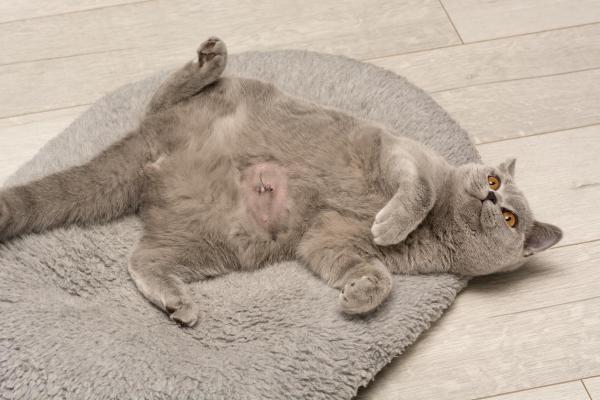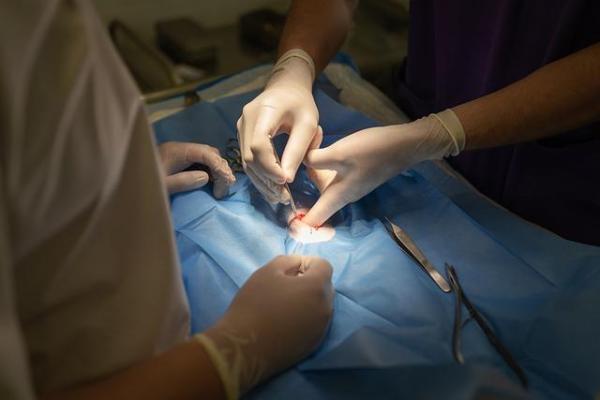
Hernias can affect various parts of a cat's body, with location determining certain symptoms and behavior. Some hernias may not show any evident signs, at least at first. This is the case with umbilical hernias in cats. The growth caused by the hernia will vary in size, depending on its severity. In some cases, this hernial sac will go unnoticed, in others the growth will worsen until the problem threatens the cat's overall health.
At AnimalWised, we take a closer look at umbilical hernia in cats. We understand the causes, symptoms and treatment options available for this problem so you might know what to expect if your cat is affected by an umbilical hernia.
What is an umbilical hernia in cats?
Unlike many other mammals, cats have a navel (commonly known as the belly button). It is usually difficult to see, especially in cats with long or thick hair. The navel is created by the scar that remains in the abdomen when the umbilical cord is broken. The umbilical cord connects the fetus with the placenta during pregnancy to provide oxygen and nutrients.
Once the kitten is born, the umbilical cord is no longer required. The newborn will respire on their own and obtain milk form their mother for sustenance, as will their siblings. Generally, the mother cat cuts the umbilical cord herself by biting or chewing it off. When this happens, the blood vessels break and then close over to prevent pathogens such as bacteria, viruses and fungi from entering.
A problem can occur when the umbilical cord does not close over properly. If the area where the cord is bisected is open, pathogens such as bacteria, viruses or fungi can enter the kitten's blood stream. The reason an umbilical hernia can occur is due to abdominal content escaping through this opening. Umbilical hernia in cats have three main parts:
- Hernial portal: between the inner and outer abdominal layer.
- Hernial sac: a pouch-like protrusion that has contents inside.
- Hernia content: what constitutes the hernia itself, contained within the hernial sac. If the space in the inner layer of the abdominal wall is large enough, it can trap a section of intestine, interrupting blood circulation in the process.
Sometimes umbilical hernias are associated with other types of hernias in cats. One common type often confused with umbilical hernias are congenital inguinal hernias. This latter hernia occurs due to a defect in the inguinal rings through which the feline uterine ligament and spermatic cord can pass, in addition to vessels and nerves.
Types of umbilical hernia in cats
Umbilical hernias in cats appear at the moment of birth, when the opening does not close or takes an extended period of time to do so. When they occur, it creates a portal between the abdominal wall and the abdominal cavity which should not otherwise be present. It is through this aperture viscera such as fat, omentum or loops of the small intestine herniate. The result is that umbilical hernia can be:
- Open umbilical hernia: when the ring is open and herniated content can be reintroduced into the abdomen by putting pressure on the area. In this case, the hernia will disappear until pressure is removed.
- Closed umbilical hernia: when the ring closes and the contents cannot be reintroduced.
- Strangulated umbilical hernia: when the herniated content was part of the intestinal loop and the ring was subsequently closed. Blood circulation is compromised, causing strangulation of ther herniated tissue.
Causes of umbilical hernia in cats
Generally, umbilical hernias in cats have a hereditary basis and are congenital in nature. Cats with this genetic predisposition usually have a weak connective tissue present from birth. It appears several genes are involved in causing this hereditary influence, since studies have observed a high incidence of umbilical hernias in some families of cats from a specific breed.
In a smaller percentage of cases, the causes of umbilical hernias are trauma. Such trauma can include falls, blows or fights, the latter usually occurring with siblings. It is possible metabolic nutritional disorders are an influence and pregnancy in later life can lead to an umbilical hernia.
Symptoms of umbilical hernia in cats
Umbilical hernias can be observed with the naked eye when we see a bulge in the navel area of newborn kittens. Generally, they will not show any other symptoms other than the herniated abdominal tissue. The size varies depending on the herniated content and quantity. These hernias can grow over time in kittens.
The severity and types of symptom of a feline umbilical hernia depend on the size and the structures affected. Strangulated hernias are potentially life-threatening for the cat and clinical signs such as the following may be seen:
- Abdominal pain
- Frequent urination
- Vomiting
- Lethargy
- Anorexia
- Lack of appetite
- Constipation

Treatment for umbilical hernia in cats
The solution of umbilical hernias in cats is usually a surgical intervention, especially in urgent cases due to strangulation. In these cases, the hernia can suddenly grow very large and the above clinical signs can be observed.
In small hernias without symptoms, observation and monitoring is usually sufficient. As long as the abdominal organs are not compromised, the cat can usually live a normal life. In kittens with non-symptomatic or strangulated umbilical hernia, it is possible the veterinarian wait until they are at the right age to be neutered, in which case they can perform sterilization and removal of the hernia at the same time. In doing so, they reduce stress to the young cat.
Umbilical hernia operation in cats
The operation of hernias in cats consists of the reintroduction of the herniated content into the abdominal cavity of the feline and the closing of the opening to prevent it from coming out again. The cat will need to undergo general anesthesia so that it does not feel pain or be aware of the procedure.
Before opening the area, it is prepared aseptically. The surgeon then incises the skin in an oval shape around the hernial defect and dissects the subcutaneous tissue to find the edges of the hernia ring. Once found, adhesions should be dissected (if they are found), as well as the hernial ring.
If there is ischemic content due to strangulation, it must be eliminated by making the appropriate ligatures and sutures. In the case of reducible hernias, the content is reintroduced into the abdomen without the need for ligatures. Finally, the hernial defect and the abdominal wall are closed.
This article is purely informative. AnimalWised does not have the authority to prescribe any veterinary treatment or create a diagnosis. We invite you to take your pet to the veterinarian if they are suffering from any condition or pain.
If you want to read similar articles to Umbilical Hernia in Cats - Causes, Symptoms & Treatment, we recommend you visit our Other health problems category.
- Nelson, R. W. (2020). Small animal internal medicine. Grupo Asís Biomedia, SL
- Veterinary Portal. (2010). Correction of the defect in the umbilical closure. Retrieved from: https://www.portalveterinaria.com/animales-de-compania/articulos/19395/correccion-del-defecto-en-el-cierre-umbilical.html